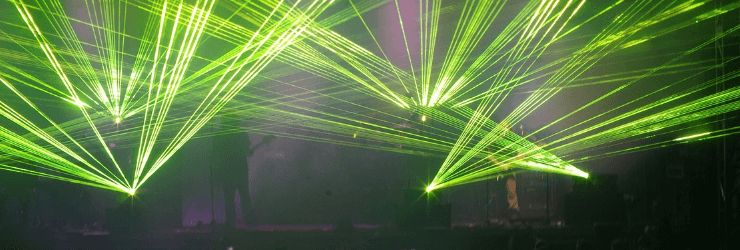History of Laser Light Shows

The modern definition of a laser light show is a show where the laser is the main attraction. Laser light shows typically choreograph project scanned laser images and beam effects with a music soundtrack for a complete entertainment experience. The history of early laser shows indicate they were often static beam array sculptures without the scanned imagery and the lasers were an element of the show along with other art works.
Holograms
The early history of the artistic use of light lasers was in the creation and display of holograms, with exhibits being reported as early as 1970. Holograms continue to be a popular art form almost fifty years later.
Optical transforms
Optical transforms, also known as diffraction patterns, were a very popular form in the early history of laser art. An optical transform is created by projecting laser light through an aperture and observing the results on a screen. The aperture used for the transforms was typically a black and white image recorded onto high contrast 35mm film. The resulting projected patterns were often very complex and artistic.
Early Laser Art Shows
European artists began using projected laser images in their theatrical work in 1968, the same year that “Sonovision” was invented, using lasers to project “a visual display of sound”, taking a loudspeaker with a reflective membrane stretched over it and a laser pointed at the reflective surface which produced patterns on a wall or screen in time to the music fed to the loudspeaker.
The history of the early 1970’s indicates the use of multiple reflections of laser beams. Laser film and laser photography were also created around this time to form black-and-white and colour “Lasergrams”.
X-Y Scanning
The early history of laser light shows indicate a reliance on images created by mirrors attached to loudspeakers, scanning of the laser beam with motorised spinning mirrors, electromagnet-controlled springs and other techniques. The patterns were interesting, but they lacked the precise control necessary to accurately position the beam.
The first laser projection systems to display large scale images were the first true laser light shows in history, used at concerts where as many people attended for the laser as for the music.
The modern laser light show projector is the X-Y scanning system which allows for drawing with light to create abstract and cycloid effects. With today’s precision, high-speed, position-detecting galvanometers, scanned graphics and animations are possible.
Early Laser Light Shows
The ongoing history of laser light has seen many improvements. Images began to be projected and reflected onto the floor of the room. Lights were beamed to create a 3D experience. By 1971 the first large-scale laser projections were used, with images projected onto a 40 by 40 ft screen and generated by a complex of optical glass, fibre optics, rippled plastics and mirrors.
Only live laser projection can capture the excitement of their effects. Laserium was the first company to commercialise the laser light show as a form of entertainment and is acknowledged as the father of the laser light show industry. The shows were choreographed to recorded music and the laser portion was performed live. Shows typically took place in planetariums due to the very effective background, with the laserist reacting to the audience and creating a unique show.
Lovelight
With the advent of position-detecting galvos and microcomputers, it became possible to accurately position the beam, thus allowing for the projection of words, pictures and animations with the laser. Early systems used images created with a digitising pad and stored in PROMs for X-Y playback. This gave a limited number of graphic images in the show to complement the mostly non-representational imagery.
Star Wars
The “Star Wars” movie generated public interest in symphony concerts with “Music from Outer Space” themes. The orchestras performed the musical selections in conjunction with lighting, lasers and special effects. Krypton lasers were used for the red beams, and argon lasers for the blue and green beams. Two high-power xenon slide projectors with a dissolver unit were also used to project images onto the three-story backdrop/screen behind the symphony.
Steroscopic Laser 3D
Another milestone in the development of laser light show technology was the first presentation of stereoscopic laser 3D. The laser projection system used one scan pair for each of the left and right eye images. Polarising material was mounted in front of each scan head in an orthogonal orientation. The audience viewed the presentation using orthogonally polarised glasses, giving the perception of full colour images in 3D.
The future of laser shows
Interest in laser displays remains high. The continuing evolution of laser technology could give rise to even more spectacular effects in the future. The brilliant, focused colours of laser beams offer endless possibilities for ongoing innovation at the intersection of art and science.
